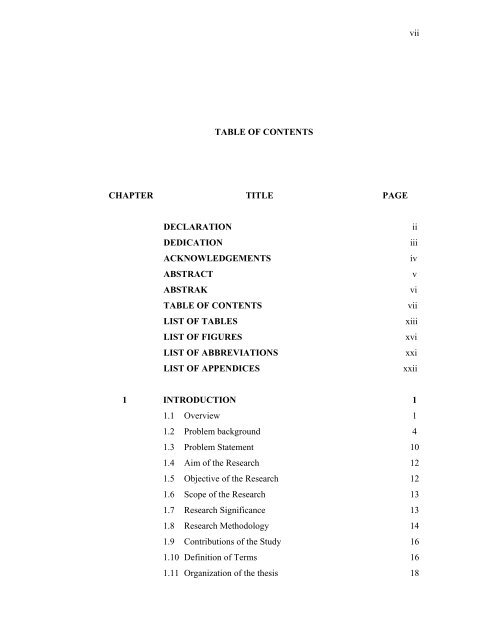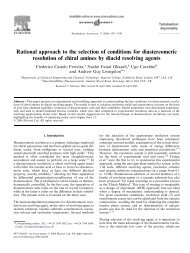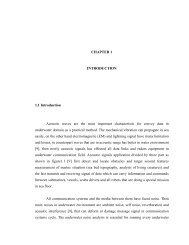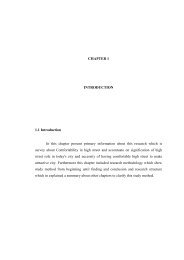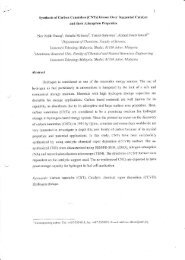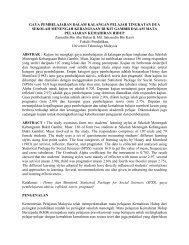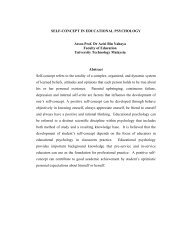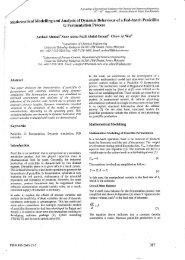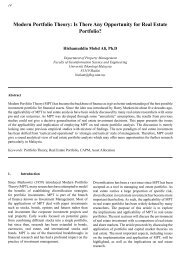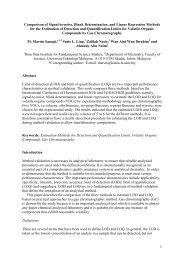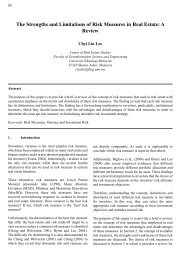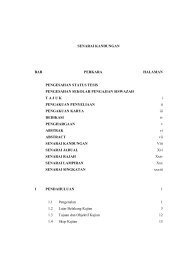vii TABLE OF CONTENTS CHAPTER TITLE PAGE DECLARATION ii ...
vii TABLE OF CONTENTS CHAPTER TITLE PAGE DECLARATION ii ...
vii TABLE OF CONTENTS CHAPTER TITLE PAGE DECLARATION ii ...
Create successful ePaper yourself
Turn your PDF publications into a flip-book with our unique Google optimized e-Paper software.
<strong>TABLE</strong> <strong>OF</strong> <strong>CONTENTS</strong><br />
<strong>CHAPTER</strong> <strong>TITLE</strong> <strong>PAGE</strong><br />
<strong>DECLARATION</strong> <strong>ii</strong><br />
DEDICATION <strong>ii</strong>i<br />
ACKNOWLEDGEMENTS iv<br />
ABSTRACT v<br />
ABSTRAK vi<br />
<strong>TABLE</strong> <strong>OF</strong> <strong>CONTENTS</strong> <strong>v<strong>ii</strong></strong><br />
LIST <strong>OF</strong> <strong>TABLE</strong>S x<strong>ii</strong>i<br />
LIST <strong>OF</strong> FIGURES xvi<br />
LIST <strong>OF</strong> ABBREVIATIONS xxi<br />
LIST <strong>OF</strong> APPENDICES xx<strong>ii</strong><br />
1 INTRODUCTION 1<br />
1.1 Overview 1<br />
1.2 Problem background 4<br />
1.3 Problem Statement 10<br />
1.4 Aim of the Research 12<br />
1.5 Objective of the Research 12<br />
1.6 Scope of the Research 13<br />
1.7 Research Significance 13<br />
1.8 Research Methodology 14<br />
1.9 Contributions of the Study 16<br />
1.10 Definition of Terms 16<br />
1.11 Organization of the thesis 18<br />
<strong>v<strong>ii</strong></strong>
<strong>v<strong>ii</strong></strong>i<br />
1.12 Summary 20<br />
2 LITERATURE REVIEW 21<br />
2.1 Introduction to Forecasting 21<br />
2.2 Types of Forecasting 22<br />
2.2.1 Causal Econometric Models 23<br />
2.2.2 Time Series Models 23<br />
2.3 Classification of Time Series Model 24<br />
2.3.1 Univariate Time Series Models 24<br />
2.3.2 Multivariate Time Series Models 25<br />
2.4 Artificial Intelligence (AI) Model in Time Series 28<br />
Forecasting<br />
2.4.1 Comparative Studies on ANN 30<br />
Forecasting Performance <br />
2.5 Hybrid Model 31<br />
2.5.1 Linear-linear Models 31<br />
2.5.2 Nonlinear-nonlinear Models 32<br />
2.5.3 Linear-Nonlinear Models 35<br />
2.6 Existing Benchmarking for Univariate Time<br />
Series with Hybrid Linear-Nonlinear Models<br />
40<br />
2.6.1 Type of Data Series Used 42<br />
2.6.2 Incomplete and Scarcity of Data 42<br />
2.6.2.1 Grey Theory 44<br />
2.6.3 Feature Selection 45<br />
2.6.3.1 Grey Relational Analysis (GRA) 49<br />
2.6.3.2 Artificial Neural Network (ANN) 53<br />
2.6.3.3 Regressions 53<br />
2.6.3.4 Rough Set 54<br />
2.6.4 Sequence of Hybridization 56<br />
2.6.5 Local Minimum Problem 56<br />
2.6.5.1 Particle Swarm Optimization 58<br />
2.7 The Rationale of using ARIMA and BPNN as Linear 61
and Non Linear Model in Proposed Hybrid Model<br />
2.7.1 ARIMA as Linear Model 61<br />
2.7.2 BPNN as Nonlinear Model 62<br />
2.7.2.1 BP Learning Algorithm 64<br />
2.8 Summary 66<br />
3 RESEARCH METHODOLOGY 68<br />
3.1 Introduction 68<br />
3.2 Operational Framework 71<br />
3.3 Problem Definition 72<br />
3.4 Proposed Cooperative Feature Selection (CFS) 72<br />
3.5 Proposed Hybrid GRANN_ARIMA Model 73<br />
3.5.1 Development of Forecasting Model 73<br />
3.5.1.1 Development of BPNN Model 73<br />
3.5.1.2 Development of ARIMA Model 77<br />
3.5.2 Integration of Forecasting Values 80<br />
3.6 Proposed Hybrid GBPSO_ARIMA Model 82<br />
3.7 Model Evaluation 82<br />
3.7.1 Quantitative Error Measurement 82<br />
3.7.2 Comparative Model Performance 84<br />
3.7.3 Hypothesis Testing 84<br />
3.7.4 Stability and Adaptability Analysis 84<br />
3.7.5 Diagnostic Test: Ljung Box Test 85<br />
3.8 Experimental Design 85<br />
3.8.1 SAMPLE DATA SET 1: China Crop Yield 86<br />
3.8.2 SAMPLE DATA SET 2: KLSE Closing Price 87<br />
3.8.3 SAMPLE DATA SET 3: Composite Index 89<br />
3.8.4 SAMPLE DATA SET 4: TEE of Natural Rubber<br />
Products<br />
90<br />
3.9 Summary 92<br />
ix
4 PROPOSED COOPERATIVE FEATURE SELECTION 93<br />
4.1 Introduction 93<br />
4.2 Implementation of Cooperative Feature Selection<br />
Model (CFS)<br />
94<br />
4.2.1 GRA Analyzer 95<br />
4.2.2 ANN Optimizer 95<br />
4.2.3 Cooperative Feature Selection Algorithm 97<br />
4.3 KLSE Closing Price Using CFS Model 99<br />
4.3.1 Implementation of GRA Analyzer on KLSE<br />
Closing Price<br />
100<br />
4.3.2 Implementation of ANN Optimizer on KLSE<br />
Closing Price<br />
104<br />
4.4 Result and Analysis of CFS Model 107<br />
4.4.1 China Crop Yield 107<br />
4.4.2 Composite Index Close Price 109<br />
4.4.3 TEE of Natural Rubber Product (NRP) 111<br />
4.5 Comparative Analysis of CFS 113<br />
4.5.1 Comparison with BPNN Model 114<br />
4.5.2 Comparison with MR and RS 116<br />
4.5.3 Comparison with ANN using Feature Selected 131<br />
by MR<br />
4.6 Result and Discussion 132<br />
4.7 Summary 135<br />
5 PROPOSED HYBRID GRANN_ARIMA MODEL 136<br />
5.1 Introduction 136<br />
5.2 The Design of the GRANN_ARIMA Model 136<br />
5.3 Development of Nonlinear GRANN Model 138<br />
5.4 Development of Linear ARIMA Model 143<br />
5.4.1 Development of ARIMA Model for KLSE<br />
Closing Price<br />
144<br />
5.4.2 ARIMA Model for Crop Yield, Composite Index 149<br />
TEE of NRP<br />
x
5.5 Integration of the Hybrid GRANN_ARIMA Model 150<br />
5.6 Evaluation of the GRANN_ARIMA Model Performance 154<br />
5.6.1 Quantitative Errors for GRANN_ARIMA 154<br />
5.6.2 Comparative Performance of GRANN_ARIMA 155<br />
5.6.2.1 GRANN_ARIMA and Individual Model 155<br />
5.6.2.2 GRANN_ARIMA and ARIMA_ANN 159<br />
5.6.2.3 GRANN_ARIMA and MR_ANN 163<br />
5.6.2.4 GRANN_ARIMA with MR and MARIMA 164<br />
5.6.3 Significant Test of GRANN_ARIMA 167<br />
5.7 Result and Discussions 177<br />
5.8 Summary 184<br />
6 PROPOSED HYBRID GBPSO_ARIMA MODEL 186<br />
6.1 Introduction 186<br />
6.2 The Hybrid GBPSO_ARIMA Model 186<br />
6.3 Determine BPNN Initial Weights Using PSO 188<br />
6.4 Development of Nonlinear GBPSO Model and<br />
Forecasting Result<br />
191<br />
6.4.1 GBPSO Forecasting Model for KLSE<br />
Closing Price Data<br />
192<br />
6.5 Development of Linear ARIMA Model and Forecasting 194<br />
Result<br />
6.5.1 Development of ARIMA Model for KLSE Closing 195<br />
Price Residual<br />
6.6 Integration of the GBPSO_ARIMA Model 199<br />
6.7 Evaluation of the Hybrid GBPSO_ARIMA Model 202<br />
6.7.1 Quantitative Errors Evaluations 203<br />
6.7.2 Comparative Performance 204<br />
6.7.2.1 BPSO and BP 205<br />
6.7.2.2 GBPSO and BPSO 206<br />
6.7.2.3 GBPSO and MLPSO 206<br />
6.7.2.4 GBPSO, GRANN_ARIMA and<br />
GBPSO_ARIMA<br />
208<br />
xi
6.7.3 Stability Analysis and Adaptability of the<br />
GBPSO_ARIMA<br />
209<br />
6.7.4 Significant Test of GBPSO_ARIMA 213<br />
6.8 Result and Discussion 217<br />
6.9 Summary 220<br />
7 CONCLUSION AND FUTURE WORK 221<br />
7.1 Introduction 221<br />
7.2 Summary of the Research 221<br />
7.3 Discussion on the Findings of the Research 224<br />
7.3.1 Cooperative Feature Selection (CFS) 224<br />
7.3.2 Hybrid GRANN_ARIMA Model 226<br />
7.3.4 Hybrid GBPSO_ARIMA Model 229<br />
7.4 Research Contributions 231<br />
7.4.1 The Informative and Robust Cooperative 231<br />
Feature Selection (CFS)<br />
7.4.2 A New Sequence of Hybridizing Nonlinear-Linear 231<br />
Model<br />
7.4.3 An Accurate, Robust and Reliable Hybrid<br />
Hybrid Nonlinear - Linear Model<br />
232<br />
7.4.4 A New Hybrid Model that Reduce<br />
The Local Minimum and Over Fitting<br />
233<br />
7.4.5 A Hybrid Model Performs Well in<br />
Short and Long Term Forecasting<br />
233<br />
7.5 Future Research 234<br />
7.6 Publications 235<br />
REFERENCES 237<br />
APPENDICES A-D 262-272<br />
x<strong>ii</strong>
LIST <strong>OF</strong> <strong>TABLE</strong>S<br />
<strong>TABLE</strong> NO. <strong>TITLE</strong> <strong>PAGE</strong><br />
x<strong>ii</strong>i<br />
2.1 Summary of previous studies on hybrid linear<br />
and nonlinear model<br />
37<br />
2.2 Six main tasks in PSO 59<br />
2.3 Standard PSO algorithm 60<br />
3.1 The differences between ARIMA_ANN and GBPSO_ARIMA 70<br />
3.2 Type of models 79<br />
4.1 The KLSE closing price before normalization 99<br />
4.2 KLSE closing price after normalization 101<br />
4.3 Grey relational coefficients for KLSE closing price 102<br />
4.4 Unordered GRG sequence for KLSE close<br />
price affecting factors<br />
102<br />
4.5 GRG for each of KLSE affecting factors (ordered) 103<br />
4.6 Results yield from ANN optimizer 106<br />
4.7 Affecting factors for KLSE closing price selected by GRA 107<br />
4.8 The unordered GRG for Crop yield 108<br />
4.9 The GRG ordered GRG for Crop yield 108<br />
4.10 The unordered GRG for Composite Index 110<br />
4.11 The ordered GRG for Composite Index 110<br />
4.12 The unordered GRG for TEE 111<br />
4.13 The ordered GRG for each TEE 112<br />
4.14 Results for BPNN and CFS_ANN 115<br />
4.15 Statistical test for multiple regression model validation 120<br />
4.16 Transformed data for Crop Yield 121<br />
4.17 Selected features by MR, CFS and RS 128
4.18 Statistical error test for MR, RS and CFS 130<br />
4.19 Statistical error produced by CFS and ANN (MR) 131<br />
4.20 Statistical error and accuracy performance 133<br />
5.1 Training error for different network structures 139<br />
5.2 Training GRANN model with various learning 140<br />
parameters , <br />
5.3 Forecasted KLSE closing price by GRANN (4-9-1) 141<br />
5.4 Statistical test for KLSE closing price 142<br />
5.5 Parameters setting and statistical errors for GRANN model 142<br />
5.6 Error yield from ARIMA model for KLSE closing<br />
price residual<br />
147<br />
5.7 ARIMA model for each dataset 150<br />
5.8 Hybridization of nonlinear _ linear model, GRANN_ARIMA 152<br />
5.9 GRANN model and ARIMA model for each dataset 153<br />
5.10 Ultimate forecasting values obtained from GRANN_ARIMA 153<br />
5.11 Statistical error test for all datasets 155<br />
5.12 Individual model Vs GRANN_ARIMA 156<br />
5.13 The forecasting performance of GRANN_ARIMA<br />
and ARIMA_ANN<br />
160<br />
5.14 Comparative studies between GRANN_ARIMA<br />
and MR_ANN<br />
164<br />
5.15 Comparative Results for GRANN_ARIMA,<br />
MR and MARIMA<br />
165<br />
5.16 One sample test for Crop yield 168<br />
5.17 One sample test for KLSE closing price 169<br />
5.18 One sample test for Composite Index 170<br />
5.19 One sample test for TEE of NRP 170<br />
5.20(a) Statistics and correlations for Crop yield 171<br />
5.20(b) Paired T-test for Crop yield 172<br />
5.21(a) Statistics and correlations for KLSE closing price 173<br />
5.21(b) Paired T-test for KLSE closing price 173<br />
5.22(a) Statistics and correlations for Composite Index 174<br />
5.22(b) Paired T-test for Composite Index 175<br />
xiv
5.23(a) Statistics and correlations for TEE of NRP 176<br />
5.23(b) Paired T-test for TEE of NRP 176<br />
5.24(a) Statistical test and accuracy percentage for Crop yield 178<br />
5.24(b) Statistical test and accuracy percentage for<br />
KLSE closing price.<br />
180<br />
5.24(c) Statistical test and accuracy percentage for<br />
Composite Index<br />
181<br />
5.24(d) Statistical test and accuracy percentage for TEE of NRP 182<br />
6.1 KLSE closing price forecasted by GBPSO (4-9-1) 193<br />
6.2 Parameters setting and statistical errors for GBPSO model 194<br />
6.3 Linear ARIMA model for representing linear<br />
component in time series<br />
199<br />
6.4 Forecasted values from hybridization of nonlinear-linear<br />
model, GBPSO_ARIMA<br />
201<br />
6.5 Final forecasting values obtained from GBPSO_ARIMA 202<br />
6.6 Statistical error test for all dataset obtained from<br />
GBPSO_ARIMA<br />
203<br />
6.7 Comparative Performance between BP and BPSO 205<br />
6.8 Comparative performance between GBPSO and BPSO 206<br />
6.9 Comparative performance between GBPSO and MLPSO 207<br />
6.10 Comparative performance of GBPSO, GBPSO_ARIMA<br />
and GRANN_ARIMA<br />
208<br />
6.11 Stability and adaptability analysis of GBPSO_ARIMA 210<br />
6.12 Stability and adaptability analysis for KLSE dataset 211<br />
6.13 One sample test for GBPSO_ARIMA model 214<br />
6.14 Statistics and correlation between GBPSO_ARIMA<br />
and GRANN_ARIMA<br />
215<br />
6.15 Paired Sample T-Test for GBPSO_ARIMA and<br />
GRANN_ARIMA<br />
216<br />
6.16 Summary of the empirical results 218<br />
xv
LIST <strong>OF</strong> FIGURES<br />
FIGURE NO. <strong>TITLE</strong> <strong>PAGE</strong><br />
1.1 Scenario leading to the research problem 8<br />
1.2 Design and development phases of proposed hybrid model 15<br />
2.1 Existing hybrid linear-nonlinear model for univariate time series 41<br />
2.2 MLP network for one-step-ahead forecasting based on two<br />
lagged terms<br />
64<br />
3.1 Proposed hybrid nonlinear_liner model 69<br />
3.2 A Proposed Framework 71<br />
3.3 Processes in developing ANN model 74<br />
3.4 Box-Jenkins Procedure 79<br />
3.5 The general proposed hybrid model 80<br />
3.6 Grain crop yield from 1991-2003 87<br />
3.7 KLSE Closing Price 88<br />
3.8 Daily closing price for Composite Index 90<br />
3.9 Total export earnings (TEE) for natural rubber (NR)<br />
based products<br />
91<br />
4.1 The Proposed Cooperative Feature Selection 94<br />
4.2 Process of GRA analyzer 95<br />
4.3 Steps in ANN Optimizer 96<br />
4.4 Algorithm for Cooperative Feature Selection 98<br />
4.5 An informative ranking scheme for KLSE closing price 103<br />
4.6 Simplified CFS process 106<br />
xvi
4.7 An informative ranking scheme for China crop yield 109<br />
4.8 An Informative ranking scheme for Composite Index 110<br />
4.9 An Informative Ranking Scheme for TEE 112<br />
4.10 Generated rules for crop yield 122<br />
4.11 Generated Rules for KLSE Closing Price 123<br />
4.12 Generated rules for Composite Index Close Price 124<br />
4.13 Generated rules for TEE of Natural Rubber Products 125<br />
5.1 Components of the proposed hybrid model 137<br />
5.2 Convergence of training error for KLSE closing price 140<br />
5.3 Forecasted KLSE closing price 141<br />
5.4(a) Plot of KLSE closing price residual 144<br />
5.4(b) ACF plot for residual of KLSE closing price 145<br />
5.4(c) Residual plot of KLSE closing price 145<br />
(after first differencing)<br />
5.4(d) ACF plot for KLSE closing price residual 146<br />
(First differencing)<br />
5.4(e) PACF plot for KLSE closing price residual 146<br />
(First differencing)<br />
5.4(f) ACF Plot and Ljung-Box test for ARIMA (0, 1, 3) 148<br />
5.4(g) Normal plot for ARIMA (0, 1, 3) 148<br />
5.4(h) Histogram plot for ARIMA (0, 1, 3) 149<br />
5.5 Comparative performance between GRANN_<br />
ARIMA and the individual model<br />
158<br />
5.6 Comparative performance between GRANN_<br />
ARIMA and ARIMA_ANN<br />
162<br />
5.7 Comparative performance between GRANN_ARIMA<br />
with MR and MARIMA<br />
166<br />
5.8(a) Comparison of the forecasting values for Crop yield 179<br />
5.8(b) Comparison of forecasting values for KLSE<br />
closing price<br />
180<br />
5.8(c) Comparison of forecasting values for Composite Index 182<br />
x<strong>v<strong>ii</strong></strong>
x<strong>v<strong>ii</strong></strong>i<br />
5.8(d) Comparison of forecasting values for TEE of NRP 184<br />
6.1 Implementation of hybrid GBPSO_ARIMA model 188<br />
6.2 Component of GBPSO forecasting model 192<br />
6.3 Forecasted KLSE closing price using GBPSO 193<br />
6.4(a) Plot of KLSE closing price residual 195<br />
6.4(b) ACF Plot of KLSE closing price residual 196<br />
6.4(c) First differencing of KLSE residual closing price plot 196<br />
6.4(d) ACF and PACF plot after first differencing 197<br />
6.4(e) Summary of the ARIMA(2,1,2) model parameter 197<br />
6.4(f) ACF Plot and Ljung Box Test for ARIMA (2, 1, 2) 198<br />
6.4(g) Histogram and normal plot of ARIMA (0, 1, 3) for KLSE 198<br />
6.5 Linear trend-line Analysis 212<br />
6.6 Predicted values produced by GBPSO_ARIMA and<br />
GRANN_ARIMA<br />
219<br />
7.1 Problems Overview and Solution 223
LIST <strong>OF</strong>ABBREVIATIONS<br />
<br />
<br />
<br />
<br />
AI Artificial Intelligence<br />
ANN Artificial Neural Network<br />
ARMA Autoregressive Moving Average<br />
ARIMA Autoregressive Integrated Moving Average<br />
ARIMA_ANN Autoregressive Integrated Moving Average<br />
_Artificial Neural Network<br />
ARCH Autoregressive Conditional Heteroscedaticity<br />
BP Backpropagation<br />
BPSO Backpropagation Particle Swarm Optimization<br />
neural network<br />
BPNN Backpropagation Neural Network<br />
CFS Cooperative Feature Selection<br />
FS Feature Selection<br />
GA Genetic Algorithm<br />
GARCH Generalized Autoregressive Conditional<br />
Heteroscedastic<br />
GRA Grey Relational Analysis<br />
GRG Grey Relational Grade<br />
GRANN Grey Relational Artificial Neural Network<br />
GRANN_ARIMA Grey Relational Artificial Neural Network_<br />
Autoregressive Integrated Moving Average<br />
GBPSO Grey Backpropagation Particle Swarm<br />
Optimization GBPSO<br />
GBPSO_ARIMA Grey Backpropagation Particle Swarm<br />
Optimization_ Autoregressive Integrated<br />
Moving Average<br />
xix
MAD Mean Absolute Deviation<br />
MAPE Mean Average Percentage Error<br />
MARIMA Multivariate Autoregressive Integrated Moving<br />
Average<br />
MLP_PSO Multilayer Perceptron Particle Swarm<br />
Optimization<br />
MR Multiple Linear Regression<br />
MR_ANN Multiple Linear Regression_ Artificial Neural<br />
Network<br />
MSE Mean Square Error<br />
NRP Natural Rubber Products<br />
PSO Particle Swarm Optimization<br />
RS Rough Set<br />
RMSE Root Mean Square Error<br />
RNN Recurrent Neural Network<br />
SARIMA Seasonal Autoregressive Integrated Moving<br />
Average<br />
STAR Smoothing Transition Autoregressive<br />
SVM Support Vector Machine<br />
TAR Threshold Autoregressive<br />
TEE Total Export Earnings<br />
TSF Time Series Forecasting<br />
xx
LIST <strong>OF</strong> APPENDICES<br />
APPENDIX <strong>TITLE</strong> <strong>PAGE</strong><br />
A Dataset 1: CHINA Crop Yield 261<br />
B Dataset 2: KLSE Closing Price 262<br />
C Dataset 3: Composite Index Close Price 269<br />
D Dataset 4: Total Export Earnings (TEE)<br />
oF Natural Rubber Products<br />
271<br />
xxi


